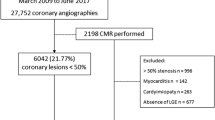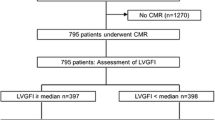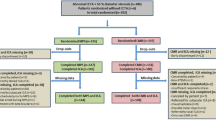Abstract
Background
Cardiac magnetic resonance imaging (CMR) has become a diagnostic modality that allows for prognostic risk stratification in various cardiac diseases. CMR derived detection of myocardial necrosis by late gadolinium enhancement (LGE) and assessment of left ventricular functional parameters such as left-ventricular ejection fraction (LVEF) have been proven to be significantly associated with outcome and prognosis. Our study focusses on the validation of specific thresholds for these parameters in a multi-center daily all-comers cohort of stable coronary artery disease (CAD) patients.
Methods
Multi-center data from tertiary high-volume CMR centers were pooled. Patients referred for viability testing for known or suspected CAD were enrolled. Functional parameters of both ventricles and myocardial necrosis were assessed. The primary endpoint was defined as cardiac death and non-fatal myocardial infarction. A multi-model approach was used for the evaluation of the predictive power of several LVEF thresholds and LGE.
Results
The study cohort consisted of 2422 patients. Median age was 66 years; 25.9 % were female. Median follow-up was 2.86 years. During the follow-up period, 187 primary endpoints occurred. On multi-model testing, optimal thresholds for LVEF could be defined at ≤50 and ≤35 %. The addition of LGE as categorical variable further lead to a significant improvement of each risk prediction model, whilst quantification of LGE affection had no additional prognostic impact.
Conclusion
LVEF thresholds at ≤50 and ≤35 % in combination with the assessment of LGE presence allows for excellent discrimination between low, mid and high prognostic risk in stable CAD.

Similar content being viewed by others
References
Wolk MJ, Bailey SR, Doherty JU et al (2014) ACCF/AHA/ASE/ASNC/HFSA/HRS/SCAI/SCCT/SCMR/STS 2013 multimodality appropriate use criteria for the detection and risk assessment of stable ischemic heart disease: a report of the American College of Cardiology Foundation Appropriate Use Criteria Task Force, American Heart Association, American Society of Echocardiography, American Society of Nuclear Cardiology, Heart Failure Society of America, Heart Rhythm Society, Society for Cardiovascular Angiography and Interventions, Society of Cardiovascular Computed Tomography, Society for Cardiovascular Magnetic Resonance, and Society of Thoracic Surgeons. J Am Coll Cardiol 4(63):380–406
Becker M, Hundemer A, Zwicker C et al (2015) Detection of coronary artery disease in postmenopausal women: the significance of integrated stress imaging tests in a 4-year prognostic study. Clin Res Cardiol 104:258–271
Buckert D, Dewes P, Walcher T et al (2013) Intermediate-term prognostic value of reversible perfusion deficit diagnosed by adenosine CMR: a prospective follow-up study in a consecutive patient population. JACC Cardiovasc Imaging 6:56–63
Zemrak F, Petersen SE (2011) Late gadolinium enhancement CMR predicts adverse cardiovascular outcomes and mortality in patients with coronary artery disease: systematic review and meta-analysis. Prog Cardiovasc Dis 54:215–229
Reithmann C, Herkommer B, Fiek M (2016) Epicardial ventricular tachycardia substrate visualized by magnetic resonance imaging: need for a transpericardial ablation approach? Clin Res Cardiol (Epub ahead of print)
Petrov G, Kelle S, Fleck E, Wellnhofer E (2015) Incremental cost-effectiveness of dobutamine stress cardiac magnetic resonance imaging in patients at intermediate risk for coronary artery disease. Clin Res Cardiol 104:401–409
Lipinski MJ, McVey CM, Berger JS et al (2013) Prognostic value of stress cardiac magnetic resonance imaging in patients with known or suspected coronary artery disease: a systematic review and meta-analysis. J Am Coll Cardiol 27(62):826–838
Zamorano JL, Bax JJ, Rademakers FE et al (2010) Evaluation of systolic and diastolic LV function. In: The ESC textbook of cardiovascular imaging. Springer, New York, pp 307–320
Cain PA, Ahl R, Hedstrom E et al (2009) Age and gender specific normal values of left ventricular mass, volume and function for gradient echo magnetic resonance imaging: a cross sectional study. BMC Med Imaging 21(9):2
Wood PW, Choy JB, Nanda NC et al (2014) Left ventricular ejection fraction and volumes: it depends on the imaging method. Echocardiography 31:87–100
Korosoglou G, Elhmidi Y, Steen H et al (2010) Prognostic value of high-dose dobutamine stress magnetic resonance imaging in 1,493 consecutive patients: assessment of myocardial wall motion and perfusion. J Am Coll Cardiol 5(56):1225–1234
Kelle S, Roes SD, Klein C et al (2009) Prognostic value of myocardial infarct size and contractile reserve using magnetic resonance imaging. J Am Coll Cardiol 3(54):1770–1777
Kramer CM, Barkhausen J, Flamm SD et al (2013) Standardized cardiovascular magnetic resonance (CMR) protocols 2013 update. J Cardiovasc Magn Reson 15:91
Schulz-Menger J, Bluemke DA, Bremerich J et al (2013) Standardized image interpretation and post processing in cardiovascular magnetic resonance: Society for Cardiovascular Magnetic Resonance (SCMR) board of trustees task force on standardized post processing. J Cardiovasc Magn Reson 15:35
Lang RM, Bierig M, Devereux RB et al (2005) Recommendations for chamber quantification: a report from the American Society of Echocardiography’s Guidelines and Standards Committee and the Chamber Quantification Writing Group, developed in conjunction with the European Association of Echocardiography, a branch of the European Society of Cardiology. J Am Soc Echocardiogr 18:1440–1463
Thygesen K, Alpert JS, Jaffe AS et al (2012) Third universal definition of myocardial infarction. Eur Heart J 33:2551–2567
Pencina MJ, D’Agostino RB Sr, D’Agostino RB Jr et al (2008) Evaluating the added predictive ability of a new marker: from area under the ROC curve to reclassification and beyond. Stat Med 30(27):157–172
El Aidi H, Adams A, Moons KG et al (2014) Cardiac magnetic resonance imaging findings and the risk of cardiovascular events in patients with recent myocardial infarction or suspected or known coronary artery disease: a systematic review of prognostic studies. J Am Coll Cardiol 25(63):1031–1045
Catalano O, Moro G, Perotti M et al (2012) Late gadolinium enhancement by cardiovascular magnetic resonance is complementary to left ventricle ejection fraction in predicting prognosis of patients with stable coronary artery disease. J Cardiovasc Magn Reson 19(14):29
Bingham SE, Hachamovitch R (2011) Incremental prognostic significance of combined cardiac magnetic resonance imaging, adenosine stress perfusion, delayed enhancement, and left ventricular function over preimaging information for the prediction of adverse events. Circulation 12(123):1509–1518
Shaw LJ, Berman DS, Picard MH et al (2014) Comparative definitions for moderate-severe ischemia in stress nuclear, echocardiography, and magnetic resonance imaging. JACC Cardiovasc Imaging 7:593–604
Di Bella G, Siciliano V, Aquaro GD et al (2013) Scar extent, left ventricular end-diastolic volume, and wall motion abnormalities identify high-risk patients with previous myocardial infarction: a multiparametric approach for prognostic stratification. Eur Heart J 34:104–111
Krittayaphong R, Saiviroonporn P, Boonyasirinant T et al (2011) Prevalence and prognosis of myocardial scar in patients with known or suspected coronary artery disease and normal wall motion. J Cardiovasc Magn Reson 6(13):2
Krittayaphong R, Boonyasirinant T, Chaithiraphan V et al (2010) Prognostic value of late gadolinium enhancement in hypertensive patients with known or suspected coronary artery disease. Int J Cardiovasc Imaging 26(Suppl 1):123–131
Cerqueira MD, Weissman NJ, Dilsizian V et al (2002) Myocardial segmentation and registration for cardiac imaging. Standardized myocardial segmentation and nomenclature for tomographic imaging of the heart. A statement for healthcare professionals from the Cardiac Imaging Committee of the Council on Clinical Cardiology of the American Heart Association. Circulation 29(105):539–542
Radunski UK, Lund GK, Säring D et al (2016) T1 and T2 mapping cardiovascular magnetic resonance imaging techniques reveal unapparent myocardial injury in patients with myocarditis. Clin Res Cardiol (Epub ahead of print)
Author information
Authors and Affiliations
Corresponding author
Ethics declarations
Conflict of interest
The authors state that there neither exists a conflict of interest nor that there are financial information to disclose.
Rights and permissions
About this article
Cite this article
Buckert, D., Kelle, S., Buss, S. et al. Left ventricular ejection fraction and presence of myocardial necrosis assessed by cardiac magnetic resonance imaging correctly risk stratify patients with stable coronary artery disease: a multi-center all-comers trial. Clin Res Cardiol 106, 219–229 (2017). https://doi.org/10.1007/s00392-016-1042-5
Received:
Accepted:
Published:
Issue Date:
DOI: https://doi.org/10.1007/s00392-016-1042-5




